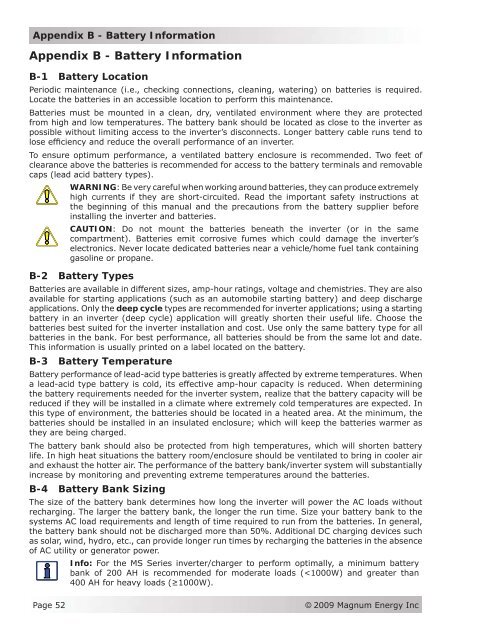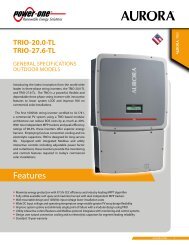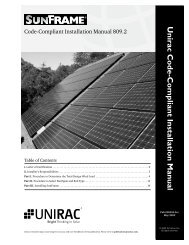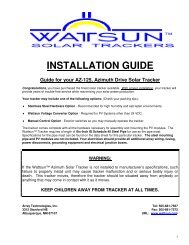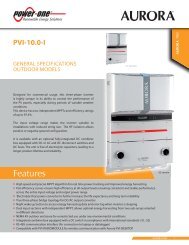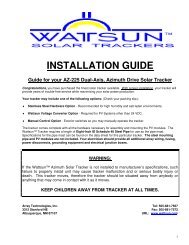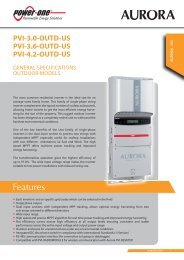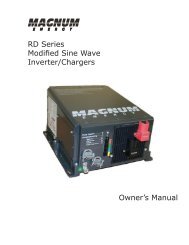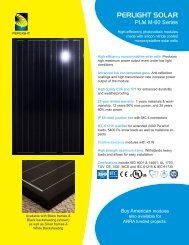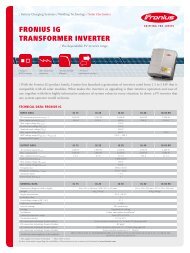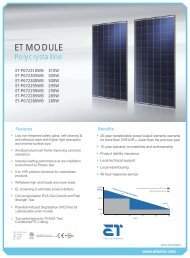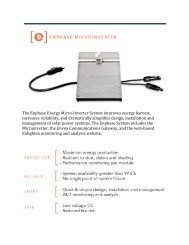MS Series Owner's Manual - Magnum Energy
MS Series Owner's Manual - Magnum Energy
MS Series Owner's Manual - Magnum Energy
Create successful ePaper yourself
Turn your PDF publications into a flip-book with our unique Google optimized e-Paper software.
Appendix B - Battery Information<br />
Appendix B - Battery Information<br />
B-1 Battery Location<br />
Periodic maintenance (i.e., checking connections, cleaning, watering) on batteries is required.<br />
Locate the batteries in an accessible location to perform this maintenance.<br />
Batteries must be mounted in a clean, dry, ventilated environment where they are protected<br />
from high and low temperatures. The battery bank should be located as close to the inverter as<br />
possible without limiting access to the inverter’s disconnects. Longer battery cable runs tend to<br />
lose efficiency and reduce the overall performance of an inverter.<br />
To ensure optimum performance, a ventilated battery enclosure is recommended. Two feet of<br />
clearance above the batteries is recommended for access to the battery terminals and removable<br />
caps (lead acid battery types).<br />
WARNING: Be very careful when working around batteries, they can produce extremely<br />
high currents if they are short-circuited. Read the important safety instructions at<br />
the beginning of this manual and the precautions from the battery supplier before<br />
installing the inverter and batteries.<br />
CAUTION: Do not mount the batteries beneath the inverter (or in the same<br />
compartment). Batteries emit corrosive fumes which could damage the inverter’s<br />
electronics. Never locate dedicated batteries near a vehicle/home fuel tank containing<br />
gasoline or propane.<br />
B-2 Battery Types<br />
Batteries are available in different sizes, amp-hour ratings, voltage and chemistries. They are also<br />
available for starting applications (such as an automobile starting battery) and deep discharge<br />
applications. Only the deep cycle types are recommended for inverter applications; using a starting<br />
battery in an inverter (deep cycle) application will greatly shorten their useful life. Choose the<br />
batteries best suited for the inverter installation and cost. Use only the same battery type for all<br />
batteries in the bank. For best performance, all batteries should be from the same lot and date.<br />
This information is usually printed on a label located on the battery.<br />
B-3 Battery Temperature<br />
Battery performance of lead-acid type batteries is greatly affected by extreme temperatures. When<br />
a lead-acid type battery is cold, its effective amp-hour capacity is reduced. When determining<br />
the battery requirements needed for the inverter system, realize that the battery capacity will be<br />
reduced if they will be installed in a climate where extremely cold temperatures are expected. In<br />
this type of environment, the batteries should be located in a heated area. At the minimum, the<br />
batteries should be installed in an insulated enclosure; which will keep the batteries warmer as<br />
they are being charged.<br />
The battery bank should also be protected from high temperatures, which will shorten battery<br />
life. In high heat situations the battery room/enclosure should be ventilated to bring in cooler air<br />
and exhaust the hotter air. The performance of the battery bank/inverter system will substantially<br />
increase by monitoring and preventing extreme temperatures around the batteries.<br />
B-4 Battery Bank Sizing<br />
The size of the battery bank determines how long the inverter will power the AC loads without<br />
recharging. The larger the battery bank, the longer the run time. Size your battery bank to the<br />
systems AC load requirements and length of time required to run from the batteries. In general,<br />
the battery bank should not be discharged more than 50%. Additional DC charging devices such<br />
as solar, wind, hydro, etc., can provide longer run times by recharging the batteries in the absence<br />
of AC utility or generator power.<br />
Info: For the <strong>MS</strong> <strong>Series</strong> inverter/charger to perform optimally, a minimum battery<br />
bank of 200 AH is recommended for moderate loads (


